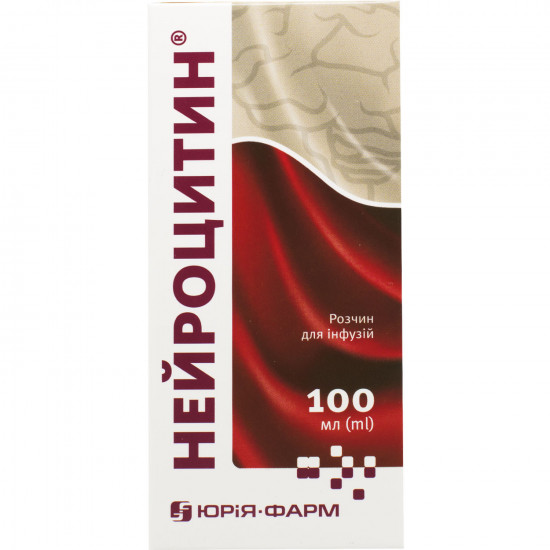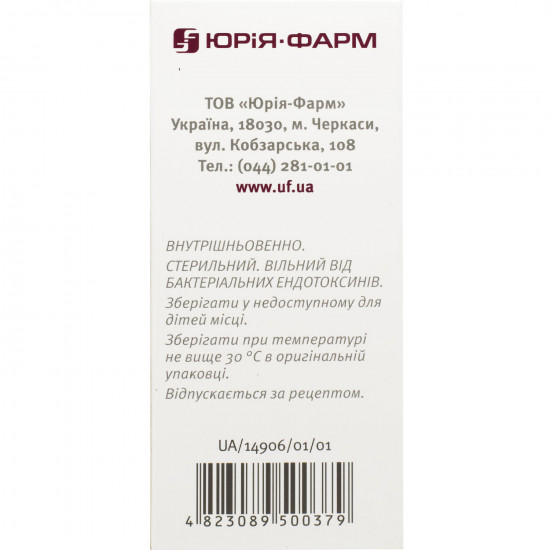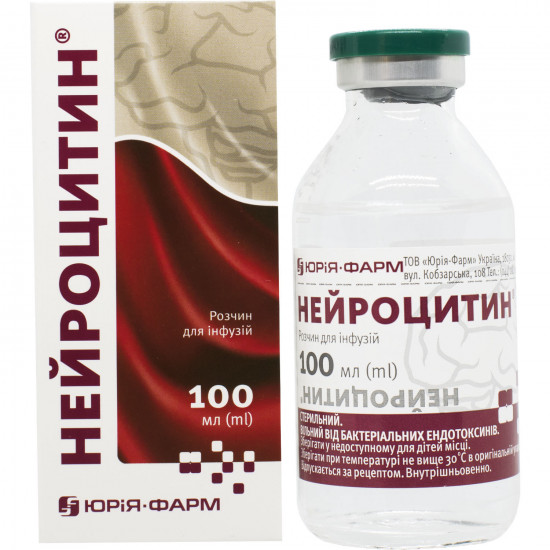







- Stock: In Stock
- Model: 176667
0% Customers recommend this product
-
5 Awesome0%
-
4 Great0%
-
3 Average0%
-
2 Bad0%
-
1 Poor0%
Reviews Over Neurotsitin solution for inf. quarrystone. 100 ml
- (0)
Total Reviews (0)
click here write review to add review for this product.
Report this review.
Description
Translation of the instruction Mose
НЕЙРОЦИТИН® solution for infusionsInstruction
For medical use of medicine
Neyrotsitin®
Ingredients:
Active ingredients:
1 ml of solution is contained: tsitikolin sodium (in terms of tsitikolin) — 10 mg, sodium chloride — 6 mg, potassium chloride — 0.4 mg, Calcii chloridum a dihydrate — 0.27 mg, sodium a lactate — 3.2 mg. Theoretical osmolarity — 288.3 mosmol;
excipients: water for injections.
Dosage form.
Solution for infusions.
Main physical and chemical properties: transparent colourless or slightly yellowish liquid.
Pharmacological group.
Solutions for intravenous application. electrolytes in a combination with other means. code atkh v05v v04.
Pharmacological properties.
Pharmacodynamics.
Neurotsitin — saline solution with the balanced content of electrolytes and a tsitikolina.
Tsitikolin stimulates withbiosynthesis of structural phospholipids in a membrane of neurons, promotes improvement of functions of membranes, including functioning of ion-exchange pumps and neuroceptors. Thanks to the stabilizing action on a membrane tsitikolin has antiedematous properties therefore reduces wet brain. Results of researches showed what tsitikolin suppresses activity of some phospholipases, interferes with residual emergence of free radicals, prevents damage of membrane systems and provides preservation of a protective antioxidant system.
Tsitikolin reduces the volume of the damaged fabric, preventing death of cages, influencing apoptosis mechanisms, and improves cholinergic transfer. Tsitikolin also has preventive neurotyre-tread effect at focal strokes of a brain.
Tsitikolin promotes fast functional rehabilitation of patients at acute disorders of cerebral circulation, reducing ischemic damage of tissues of brain that is confirmed by results of X-ray inspections. In craniocereberal injuries tsitikolin reduces duration of the recovery period and reduces intensity of a posttraumatic syndrome. Tsitikolin promotes increase in level of brain activity, reduces amnesia level, improves a state at the cognitive, sensitive and motor disorders observed at brain ischemia.
Drug fills shortage of the volume of the circulating blood. The lactate which is a part of medicine as a result of metabolic processes turns into bicarbonate anions that poorly changes reaction of blood in the alkaline party. Solution has also disintoxication effect as a result of decrease in concentration of toxic products in blood and activation of a diuresis.
Pharmacokinetics.
Tsitikolin is well soaked up byat oral, intramuscular and intravenous administration. After administration of medicine the substantial increase of level of sincaline in blood plasma is observed. Researches showed that bioavailability at oral and parenteral ways of introduction almost identical.
Drug is metabolized byin intestines and a liver with formation of sincaline and cytidine. After introduction tsitikolin it is acquired by brain tissues, at the same time sincalines affect phospholipids, cytidine — on cytidine nucleoids and nucleic acids. Tsitikolin quickly reaches tissues of a brain and is actively built in cell membranes, cytoplasm and mitochondrions, activating activity of phospholipids.
Only the insignificant quantity of the entered dose is removed bywith urine and a stake (less than 3%). About 12% of the entered dose are removed through airways. Removal of medicine with urine and through airways has two phases: the first phase — fast removal (with urine — within the first 36 hours, through airways — within the first 15 hours), the second phase — slow removal. The main part of a dose of a tsitikolin is involved in metabolism processes.
Other components of medicine (anions, cations) are removed bywith urine.
Clinical characteristics.
Indication.
− sharp phase of violations of cerebral circulation, complication and consequence of violations of cerebral circulation.
− Craniocereberal injury and its consequences.
− the Neurologic frustration (cognitive, sensitive, motor) caused by cerebral pathology of degenerative and vascular origin.
Contraindication.
− hypersensitivity to medicine components;
− the Raised tone of parasympathetic nervous system;
− Hypervolemia, hypernatremia, hyperpotassemia, hyperchloremia, Alkalosis, lactoacidosis;
− Heavy arterial hypertension, dekompensirovanny heart failure;
− Oliguria, anury;
− the Liver failure (because of reduction of formation of a hydrocarbonate from a lactate);
− Acute renal failure;
− Hypercalcemia;
− Extracellular overhydratation;
− Fluid lungs, wet brain.
Interaction with other medicines and other types of interactions.
Tsitikolin enhances effect of a levodopa. it is not necessary to appoint medicine along with the medicines containing Meclofenoxatum. at use of kaliysberegayushchy diuretics, inhibitors of angiotensin-converting enzyme (apf) and medicines of potassium risk of development of a hyperpotassemia amplifies. in case of simultaneous application with cardiac glycosides the toxic effect of the last due to presence at solution of ions sa ++ amplifies.
Drug is incompatiblewith tsefamandoly, Amphotericinum, alcohol, thiopental, aminocapronic acid, metaraminoly, ampicillin, Vibramycinum and monotsikliny. Increase in a delay of sodium in an organism at simultaneous use of such medicines is possible: non-steroidal anti-inflammatory drugs, androgens, anabolic hormones, estrogen, corticotropin, mineralokortikoid, vazodilatator or ganglioblokator.
Due to the existence of a lactate which alkalizes rn with care should apply Neyrotsitin® with medicines which kidney elimination depends from rn. The renal clearance of salicylates, barbiturates, lithium can decrease, and sympathomimetics and stimulators (such as deksamfetamin sulfate, a fenfluramina a hydrochloride) — can raise.
Feature of application.
in case of steady intracraneal hemorrhage should not exceed a dose of 100 ml a day and speed of injection of 30 drops a minute.
Should carry out bymonitoring of blood on the content of electrolytes, rn and rSO2, a lactate. Use of intravenous solutions can cause an overload liquid and/or solution, an overhydratation, developments of stagnation and a fluid lungs. Risk of development of a dilyution is inversely proportional concentration of electrolytes. Risk of development of an overload solution which causes developments of stagnation with peripheral hypostases and a fluid lungs, is directly proportional to concentration of electrolytes.
in case of any manifestations of reaction of hypersensitivity immediately to stop introduction of solution and to carry out necessary treatment.
As medicine contains sodium a lactate, with extra care it should be applied to the patients inclined to a hypernatremia (for example, adrenocortical insufficiency, not diabetes or massive damage of fabrics), and to patients with heart diseases; in connection with the maintenance of ions of sodium need to apply solution with care patients of advanced age, patients with arterial hypertension, a renal and cardiovascular failure, stagnant heart failure, especially during the postoperative period, to patients with a hypoxia and a liver failure and also to patients with the clinical states which are followed by a delay of sodium and hypostases, to the patients receiving corticosteroids or corticotropin.
byBecause of the content of potassium needs care at use of solution to patients with the heart diseases and clinical states which are followed by a potassium delay in an organism. Appointing calcium, it is necessary to control cardiac performance by means of the ECG, especially at the patients receiving a digitalis. Calcium levels in serum not always reflect calcium levels in fabrics.
prescribing of solution can leadAt patients with reduced secretory function of kidneys to a delay of sodium or potassium.
toBecause of existence in composition of medicine of calcium ions needs care at co-administration with blood preparations through a coagulation likelihood of development. It is necessary to appoint calcium parenterally to patients who receive cardiac glycosides with extra care.
Lactate is substrate for a gluconeogenesis therefore it is necessary to control carefully blood glucose level at patients with diabetes of the II type.
Use during pregnancy or feeding by a breast.
do not havedata on application of a neurotsitin to pregnant women. data on excretion of medicine in breast milk and its action on a fruit are unknown. therefore during pregnancy and feeding a breast medicine is appointed only when the expected advantage for mother exceeds potential risk for a fruit.
Ability to influence speed of response at control of motor transport or other mechanisms.
In some cases some side reactions from the central nervous system can affect ability to steer motor transport or to work with mechanisms.
Route of administration and doses.
For intravenous administration.
Recommended dose for adults makesfrom 50 ml to 200 ml a day in the form of drop injection (40–60 drops a minute).
Treatment: the first 2 weeks on 50–100 ml 2 times a day. The maximum daily dose — 200 ml.
maximum therapeutic effect is reached byAt acute and medical emergencies if medicament is used in the first 24 hours.
Dose of medicine and term of treatment depend on weight of damages of a brain and are established individually.
toPatients of advanced age does not need dose adjustment.
Children.
do not havesufficient data concerning use of medicine to children.
Overdose.
Overdose or too fast introduction of solution can leadto disturbance of water and electrolytic balance, the phenomena of an alkalosis, a cardiopulmonary decompensation. in that case introduction of medicine should be stopped immediately. to carry out symptomatic therapy.
Introduction of excess quantity of a lactate can leadto development of a metabolic alkalosis which, in turn, can be followed by a hypopotassemia.
Symptoms: change of mood, fatigue, short wind, muscle weakness, polydipsia, polyuria, violation of thinking, arrhythmia. The hyper tone of muscles, twitching and tetanic spasms can develop at patients with a hypocalcemia.
Side reactions.
Mental disorders: hallucinations.
from nervous system: severe headache, dizziness.
from a cardiovascular system: arterial hypertension, arterial hypotension, tachycardia.
from a respiratory system: dispnoe.
from a digestive tract: nausea, vomiting, diarrhea.
Disturbance of electrolytic balance: change of level of electrolytes (potassium, calcium, sodium, chlorine) in blood serum, metabolic Alkalosis, chloride acidosis.
General frustration: hypervolemia.
from the immune system: fever, hypostasis, allergic reactions, including: rash, purple, itch, Quincke's disease, acute anaphylaxis; fervescence, the increased perspiration, cough, sneezing, breath difficulty localized or generalized urticaria.
Change in the place of infusion: inflammation, hypostasis, rash, an itch, an erythema, pain, burning, numbness in the place of infusion.
Mental disorders: panic attack.
in case of side reactions introduction of solution should be stopped, to estimate a condition of the patient and to render appropriate assistance.
Expiration date.
2 years.
Storage conditions.
to Storeat a temperature not above 30 °C in original packing. to store out of children's reach.
Incompatibility.
Drug should not be mixed with other medicines in one capacity, including about phosphate - and karbonatsoderzhashchy solutions.
Packing.
On 50 ml, 100 ml, 200 ml in a bottle; on 1 bottle in a pack; on 100 ml or 200 ml in containers.
Category of a holiday.
According to the prescription.
Producer.
LLC yuriya-pharm
Location of the producer and its address of the place of implementation of activity.
Ukraine, 18030, Cherkasy, st. verbovetsky, 108.
Specifications
| Characteristics | |
| Active ingredients | Potassium chloride, Calcii chloridum, Sodium lactate, Sodium chloride, Tsitikolin |
| Applicant | Yury-pharmaceutical |
| Code of automatic telephone exchange | B05BB04 Electrolytes in a combination with other drugs |
| Interaction with food | It doesn't matter |
| Light sensitivity | Not sensitive |
| Market status | Traditional |
| Origin | Chemical |
| Prescription status | According to the prescription |
| Primary packing | bottle |
| Producer | YURY OF PHARMACEUTICAL LTD COMPANY |
| Quantity in packing | 100 ml |
| Release form | solution for infusions |
| Route of administration | Infusional |
| Sign | Domestic |
| Storage temperature | from 5 °C to 25 °C |
| Trade name | Neurotsitin |

















































